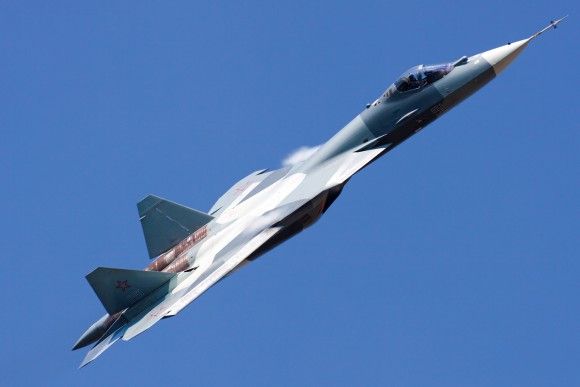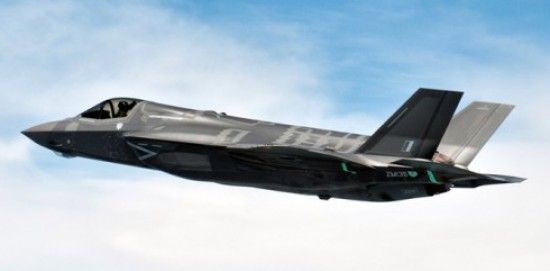From Loara To a 35 mm AAA System. PIT-RADWAR’s Contribution to the “Noteć” Programme
The anti-aircraft artillery system using the 35 mm cannons, presented by the PIT-RADWAR company during the 2016 MSPO Defence Salon, is a successor of the Loara AAA system which, despite the fact that only a single example of it has been adopted by the Polish Army, opened the way for the Polish industry towards obtaining and acquiring relevant, modern technologies existing in the field. PIT-RADWAR offers the 35 mm autonomous anti-aircraft battery primarily for the navy units, however, the system may also be successfully applied by the land or air components of the Polish Armed Forces.
The anti-aircraft system offered by the PIT-RADWAR company is based on a flexible battery structure, including single 35 mm cannons and command and guidance systems. The 35 mm cannons are offered in two variants, one of which, featuring an optoelectronic sensor, has a capacity of destroying targets independently, with the use of the autonomous mode.
The system constitutes a result of the development works undertaken within the framework of the former Loara programme which was finalized back in 2009. It is, above all, offered for the Polish Navy, as a successor for the domestically developed “Blenda” system, which was designed and created back in the 1990s. The new system may also be used by other armed services, for the purpose of point-defending the important infrastructure from air-strikes, helicopter attacks, cruise missiles or UAV systems.
Let us recall the fact that “Blenda” came in a form of a battery of 4 S-60 57 mm cannons, fitted with an automated control system and coupled with the Polish WD-95 command vehicles with electro-optical seekers. The system was designed to be operated together with the Rega-3/4 command vehicles and PIT-RADWAR N-22(3D) radars. Eight batteries of this type are being used by the Polish Navy now. Both the observation/targeting, as well as the tracking systems, along with most of electronics and the fire control system, came straight from the “Loara” programme.
“Loara”: Descendants – Modern Anti-Aircraft Solutions
Emergence of the “Blenda” system, the prototype of which has been introduced into the inventory of the Polish Army back in 1999, and the delivery process of which has been finalized in 2008, would not have been possible, had the PZA “Loara” AAA system not been developed. PIT-RADWAR had been working on the aforesaid air defence weaponry, as ordered by the Polish Ministry of Defence, since the beginning of the 1990s. The system was to come in a form of a self-propelled platform fitted with modern cannons coupled with optoelectronic and radar-based guidance and tracking systems. The prototype has been introduced into service in the Polish Army back in 2003. At the time, Loara was considered to be one of the most modern systems of its class in the world. The design, despite the fact that a sum of PLN 300 million has been spent on its development, has been cancelled in 2009.
Nonetheless, the Loara programme created tangible capabilities for the industry, which, throughout the subsequent years, have been implemented in production and introduced into service, in Poland and as export products. The aforementioned products include the “Blenda” system, along with target detection N-22N(3D) and MMSR radars, or deployable Soła 3D radar system. The product family above also includes a mobile combined missile-artillery SHORAD Kobra/Aster system, along with its elements which were also adopted for operational use by the Polish Armed Forces, namely the Poprad SAM systems. Last year, the Polish Ministry of Defence signed a procurement contract, assuming that 77 Poprad launchers would be acquired, for a sum of more than a billion zlotys.
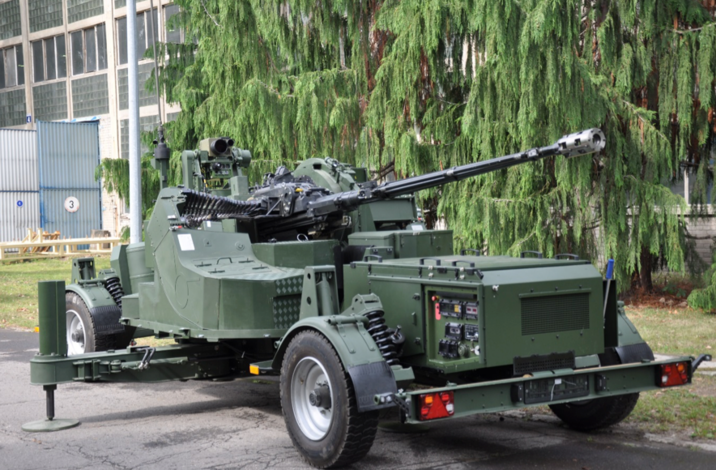
35 mm Cannon – The Tool
The 35 mm AAA system proposed by PIT-Radwar as an offer within the “Noteć” programme is connected to the effort, the aim of which is to make use of the works derived from the PZA Loara system, and the related competences. When the project was being developed, a relevant license has been acquired, allowing the Polish industry to develop and manufacture the 35 mm Oerlikon KDA cannon, constituting the core armament of the battery.
It is an automatic, gas-operated cannon, with a theoretical rate of fire of 550 rounds per minute, with a two-sided belt feed with an option of quick switch of the applied ammunition type. The barrel, air-cooled, has a length of 3150 mm, and it has been fitted with a muzzle system used for measurement and programming required in case of the ABM rounds. The cannon is capable of neutralizing targets, effectively, at range of up to 5 kilometres, flying at altitudes of 3.5 kilometres.
PIT-RADWAR (at the time known as CNPEP RADWAR) acquired the KDA cannon license within the framework of the PZA Loara programme back in 1995, for an amount of more than CHF 6 million. In the light of the fact that no justification existed to initiate the manufacturing process locally, PIT-RADWAR transferred the documentation, production equipment and other materials required to initiate the manufacturing process to the Huta Stalowa Wola facility, as a result of a free-of-charge implementation agreement. This made it possible for HSW to acquire an ability to manufacture very good anti aircraft cannons.
One of the most important features of the KDA cannon, besides its being very accurate, is the ability to feed ammunition at both sides, which makes it possible to quickly alternate between sabot and programmable rounds. Throughout the research it was proven that, contrary to the theoretical assumptions, the “airburst” type ammunition, detonated at a programmed distance, is not a solution which is universal and which could be used against any target.
It is well suited to act against soft and light-armoured targets, including infantry or UAV systems, especially at short and medium distances. However, for obvious reasons, this type of ammunition is less effective against armoured threats, including armoured vehicles or heavy attack helicopters.
The kinetic armour piercing ammunition is also more effective at longer distances, thanks to the better ballistic properties of the rounds, including parameters such as higher velocity and lower weight of the projectiles. For the KDA 35 mm cannon, a programmable 750 grams round achieves a muzzle speed of 1050 meters per second, while a sabot 550 grams round reaches the velocity of 1440 meters per seconds. This difference is very significant, and it has a major impact on combat capabilities of the projectile. Thanks to double-feed and ammunition storages housing up to 80 rounds, it is possible to make optimal use of the features of both types of ammunition mentioned above.
After the LOARA programme came to an end, PIT-RADWAR decided to continue its works on utilization of the KDA cannon. The first project came in a form of the SAN-35 research prototype, fusing the base, chassis and many elements of the S-60 57 mm cannon and of the KDA cannon, and mechanical and electronic components derived from the Loara programme, used for the purpose of controlling the cannon in vertical and horizontal planes. Twin-engined rotation system using brush-less PIT-RADWAR-designed electric motors was used, making it possible to control the movement of the cannon precisely, with minimized free-play.
Within the period between 2009 and 2011, with funding provided by the Ministry of Science and Higher Education “Remotely Controlled Anti-Aircraft System based on a 35 mm Cannon” project has been implemented, and created by the consortium formed by the Military University of Technology, PIT-RADWAR and Research and Development Centre for Mechanical Devices from Tarnów. “Zdalnie Sterowany System Przeciwlotniczy Kalibru 35 mm”, also known as ZSSP-35 “Hydra” was the result of the aforementioned initiative. The weapons system mentioned above has been presented several times during the Kielce MSPO Salon. Not only was the effector of the anti-aircraft system created and tested within the scope of the works, as numerous tests were carried out with a reference to the development of the fire control system. Targeting and tracking algorithms, as well as computerized battery and division models based on scattered structure were also a subject of the research.
As a result of those works, a design request “35 mm Anti-Aircraft Battery” was submitted back in 2011, receiving a positive opinion of the leadership of the air-defence component at the Polish Ministry of Defence, as well as of the Command of the Armed Forces. The financial support provided for the PIT-RADWAR company came in an amount of PLN 30 million, and 15 million zlotys were provided by the company itself, with the use of its own assets. In 2014, the battery structure concept was redefined, and the request was updated, with the components of the battery described below being introduced.
35 mm anti-aircraft battery – Loara light?
The 35 mm anti aircraft battery is a scattered form of the PZA Loara system, arranged into a number of separate components. The same KDA 35 mm cannon acts as the effector, however it comes on a towed chassis in the A-35 variant, with programmable sight, or in the AG-35 variant, fitted with an optronic sensor. The detection and guidance and fire control systems, along with the observation system, have been fitted onto the Żubr-P chassis, and are designated altogether as the WG-35 Fire Control Vehicle.
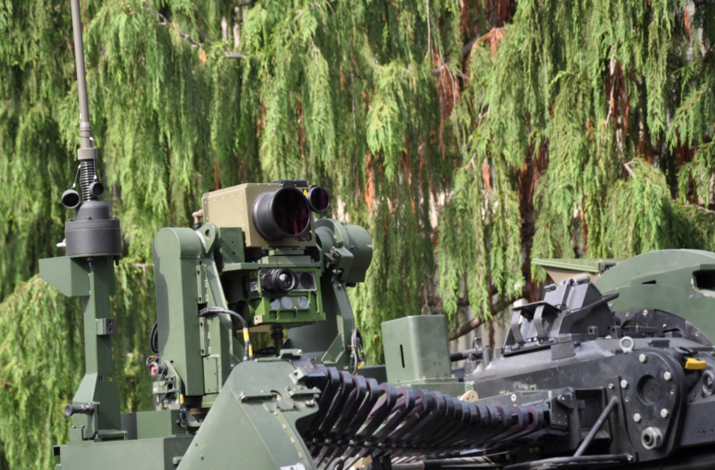
The system also features newly developed 35 mm programmable ammunition. During the development works, indispensable elements of the software suite and infrastructure for the WD-35 command vehicle were created, whereas integration with the platform itself did not take place, also for financial reasons. Currently, all that is left to be done is to select the vehicle and plan the arrangement of the infrastructural elements.
WG-35 may act as the command vehicle to some extent, since it has an ability of acquiring the information pertaining to the airspace situation from an external source. This is possible especially in cases when the battery is formed by the AG-35 autonomous systems (effectors) or Poprad systems. Controlling the A-35 cannons and commanding the system simultaneously may lead to work overload for the operator.
Two Variants of the 35 mm Cannon – The Effector
The described 35 mm anti aircraft battery uses two variants of a towed cannon based on the same chassis. Nonetheless, the weapons mentioned here are significantly different, when it comes to their capabilities. Here we mean the A-35 cannon with a programmable Prexer CP-1-35 sight, and AG-35 cannon which has been fitted with its own optronic tracking-targeting device. When it comes to the price, there is a difference of around 10%, however the final decisions shall be made at the manufacturing stage. Due to the reasons related to the technical differences, transforming the A-35 cannon into AG-35 is far from being cost-effective, while differences when it comes to capabilities have a significant degree of relevance.
The A-35 is the basic variant which, in order to be operated effectively in the automatic mode, should be connected to the WG-35 fire control vehicle, similarly as it was done in case of the S-60BM “Blenda” cannon. The A-35 cannon requires an external tracking-targeting device to be applied for the purpose of guidance.
On the other hand, the AG-35 cannon has been fitted with its own optronic sensor, the capabilities of which are quite close to those of the sensor applied in the WG-35 vehicle. It features visible-spectrum and infra-red cameras and two high frequency laser rangefinders integrated together by the PIT-RADWAR company and by the Military University of Technology. Thanks to the above, the AG-35 cannon forms an independent targeting channel which, via the command/fire control vehicle, may be used to control the A-35 systems.
In both versions, the cannon is highly mobile and may be rapidly prepared to open fire. Transition from transport to combat arrangement, with stabilization and levelling, is carried out automatically, in less than 120 seconds. The systems that need to be initiated before that, including the cooling system for the thermal vision camera or INS system may be initiated on the move.
This is possible due to the fact that the cannon has been fitted with a generator of its own, coupled with a battery pack, providing the relevant energy when on the move and during the operation. Once the A-35/AG-35 system assumes its firing position, its coordinates, in relation to the other elements of the system are defined. Then, the system may be connected to those elements via a radio connection or other means of connectivity – e.g. via fibre optics or a conventional cable. The INS/GPS system defines the system’s position in relation to the environment, while the onboard system defines the cannon’s azimuth, tilt and inclination, making continuous data adjustment possible.
The 35 mm cannon has been fitted with a precise electronic control system which controls the movement in horizontal and elevation planes with 1 mrad of accuracy which, at the distance of 1000 meters, provides the operator with 96% of probability of hitting a target, the dimensions of which are defined as 50×20 cm, with a 9 rounds burst.
WG-35 Fire Control Vehicle – The System’s Brain
The WG-35 fire control vehicle is the central element of the architecture of the 35 mm anti aircraft artillery battery. It is a significant upgrade of the solutions that had been previously applied within the “Blenda” or “Aster”/”Kobra” systems. The WG-35 platform is based on the Żubr-P all-terrain vehicle chassis, which has also been applied as a carrier for the Poprad launcher or Soła and Bystra radars.
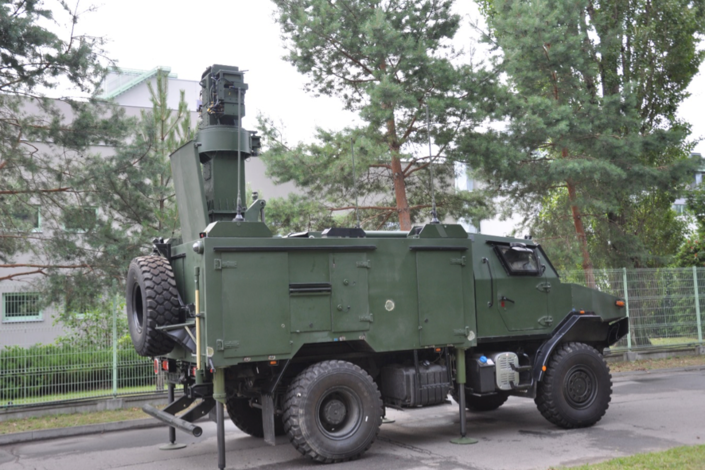
The system’s crew consists of two people, one of whom is the driver, with the second soldier working as an operator, with two screens remaining at his disposal, one of which presents the data coming from the external sources, while the second one visualizes the information transferred from the optronic sensor of the vehicle. The bottom screen, with a control panel, may be used remotely, thanks to a connection based on fibre optics. In such setting this screen acts as a portable control module.
The WG-35 vehicle has been fitted with a hydraulically lifted optronic sensor being a derivative of the ZGS-158 sensor utilized, inter alia, within the naval variant of the 35 mm AAA system. The optronic sensor is fitted with a third generation TV camera, a laser rangefinder with a high frequency of measurement, along with an IFF interrogator. The system has also been tailored for installation of a tracking radar.
The lifting system makes it possible to install a tracking radar on the vehicle, with the antenna the dimension of which cannot exceed 0.8×1 meter, surrounded with a U-layout of optronic sensors. Due to limited funds, this solution, within the framework of the National Centre for Research and Development programme, was not pursued outside the stage related to a low-level technology demonstrator. Nonetheless, the opinion issued by the ordering party, pertaining to the aforesaid option, has been very positive.
Using the radar would provide the operator with an ability to track targets in any conditions, also in cases when visibility could be limited. This could also contribute to a higher hit-rate and general capabilities offered by the WG-35 vehicle within the battery structure. In such configuration, the WG-35 platform could successfully replace the additional radars embedded within the IADS.
The vehicle also features a portable WPO observation point, consisting of a tripod, night-vision binoculars, voice communication system and a data transmission system, with the position and elevation data being transferred to the optronic system, directing the sensors towards the target detected with the use of the portable system.
What is more, the fire control vehicle has been fitted with INS/GPS suite, electricity generator, ballistic computations system and an expansive communications suite, providing the user with encrypted data transmission compliant with all the wired and wireless communication standards applied within the Polish Army, including radio communications, fibre-optics, as well as the old-fashioned PKL cables. Should communications be lost, e.g. as a result of damage of the wire, the system automatically looks for alternative transmission methods, preventing the potential data loss.
Flexible Structure Composition of the 35 mm AAA Battery
The WG-35 fire control vehicle may be used to control up to 8 effectors connected to the command platform via wired- or wireless connections, including A-35 and AG-35 cannons or Poprad SAM systems. The 35 mm AAA system may be configured in several ways, with the WG-35 fire control vehicle acting as the central element of the arrangement.
In the cheapest variant which is, at the same time, the least universal one, the “Blenda” system structure is replicated, with the WG-35 fire control vehicle acting as a commanding platform for 8 A-35 cannons sharing a single, joint targeting channel, operated in the automatic mode, providing the data for the whole battery.
The AG-35-based system is more expensive, however, at the same time, it offers greater flexibility and capability of destroying numerous targets, since every cannon is fitted with its own optronic sensor which may act as a separate targeting channel, meaning that each of the effectors may be used independently and individually, as they may track and destroy airborne targets autonomously. One of the configurations considered for the battery is a mixed one, featuring a WG-35 vehicle, with two AG-35 cannons with optronic systems, and six A-35 cannons. In this arrangement, three targeting channels are available. This potentially allows the system to destroy three separate targets at once. 2-4 A-35 cannons are being guided from the WG-35 vehicle, while each of the AG-35 cannons provides tracking and guidance data to at least one A-35 system. The system may also incorporate additional Poprad SAMs, via two radio connections, or instead of any number of A-35/AG-35 cannons.
The WG-35-controlled battery shall be a part of a wider commanding structure, with the exchange of the information and connectivity with the Soła or Bystra radars provided.
Mature Anti-Aircraft System: Polish Navy and Beyond
The 35 mm anti aircraft battery has reached a proper level of design maturity. The programmable rounds, since two years, have been undergoing the qualification tests which are to be finalized next year. All three components of the system, including the WG-35 fire control vehicles, A-35 and AG-35 cannons and the programmable ammunition, have already been integrated. PIT-RADWAR planned the first test firing of the integrated system including all of the aforesaid elements in November 2016, within the Wicko-Morskie firing range. The test firing is a part of the factory-test programme.
The Polish Navy became a pioneer, when it comes to using the 35 mm cannon which, in its AM-35 ship-borne variant, is being tested onboard the ORP “Kaszub” corvette now. The initial test results show that the project may be successful. The development of the ship-borne 35 mm artillery solution has been carried out by a consortium composed out of the following entities: Warsaw Military University of Technology (Leader), Polish Naval Academy of Gdynia, PIT-RADWAR S.A. company based in Warsaw and ZM Tarnów S.A. company from Tarnów. The initiative has been implemented within the framework of a project co-financed by the National Centre for Research and Development.
If the 35 mm automated air defence system replaces the “Blenda” anti-aircraft artillery system, using the 57 mm cannons, then this could be seen as another step taken towards introduction of this standard in other components of the Polish Armed Forces.
If the battery, featuring the WG-35 vehicle and AG/A-35 cannons is enriched with the WD-35 command platform and compatible Soła or Bystra radars and Poprad SAMs, then a complex VSHORAD system is formed by all of the aforementioned elements, combining SAMs and AAA systems. Such system may act against targets at distances of up to 6 kilometers and altitudes of up to 3500 meters, creating the lowest and the most mobile layer of the air defence system.
It is also possible to develop variants of the 35 mm cannons of a higher mobility, on self-propelled wheeled or track chassis. In such situation, a concept similar to the original assumptions of the PZA Loara system could be implemented, and the whole system could be used for protection of armoured and mechanized units on the move.

